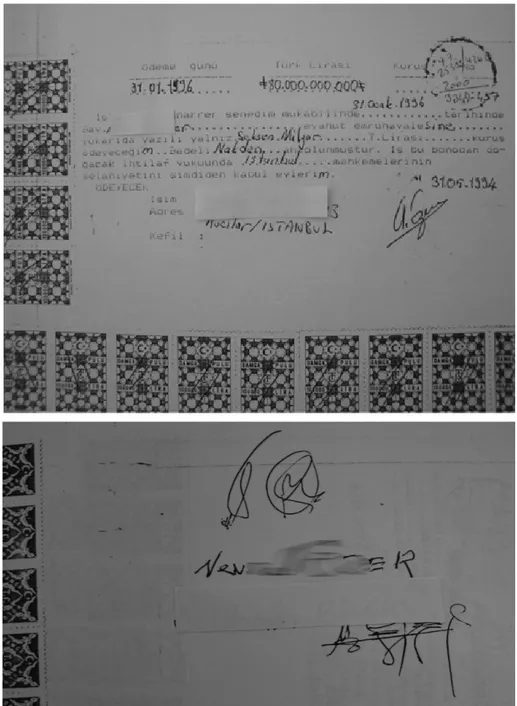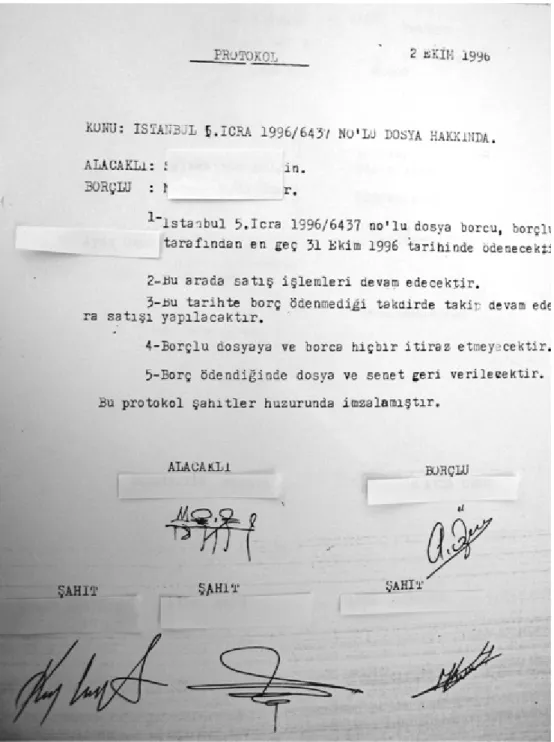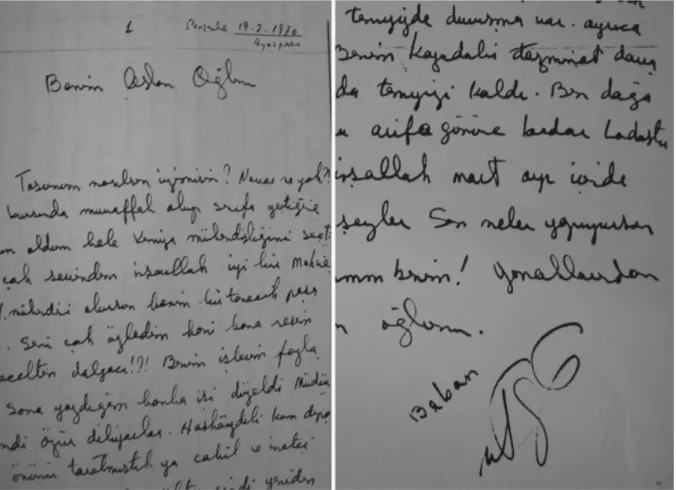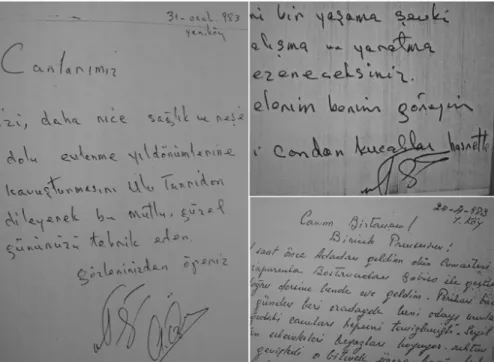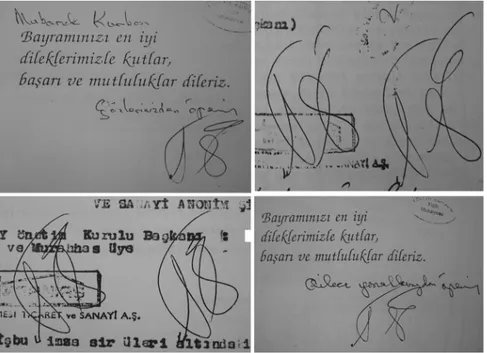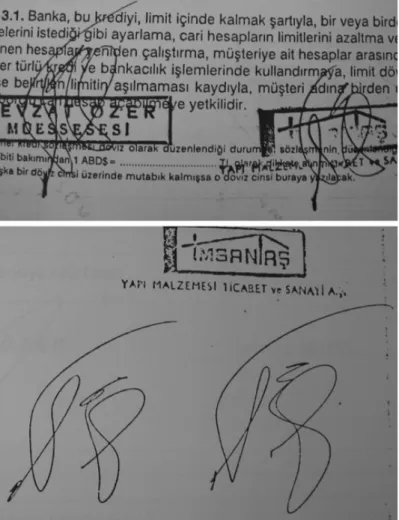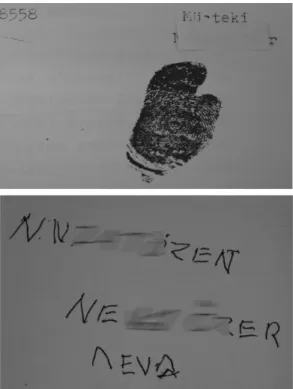Changes in Handwriting due to Alzheimer’s Disease: A Case Report
Alzheimer Hastalığına bağlı el yazısı değişiklikleri: Bir olgu sunumu
İsmail Birincioğlu1, Mustafa Uzun2, Nevzat Alkan3, Ömer Kurtaş4, Rıza Yılmaz5, Muhammet Can6 1Karadeniz Technical University School of Medicine, Department of Forensic Medicine, Trabzon
2Council of Forensic Medicine, Istanbul
3Istanbul University, Department of Forensic Medicine, Istanbul 4Kocaeli University, Department of Forensic Medicine, Kocaeli 5Bülent Ecevit University, Department of Forensic Medicine, Zonguldak 6Balıkesir University, Department of Forensic Medicine, Balıkesir
OLGU SUNUMU / CASE REPORT
Corresponding Author: Yrd.Doç.Dr.Muhammet Can Balıksir Üniversitesi, Tıp Fakültesi
Adli Tıp Anabilim Dalı, Balıkesir E-mail: balikesirmcan@gmail.com
Geliş: 23.02.2015 Düzeltme: 26.05.2015 Kabul: 26.06.2015
Abstract
Handwriting and signature comparisons are frequently per-formed in forensic investigations of documents. Mistakes in conclu-sion might be due to lack of sufficient documentation and informa-tion. Many factors can affect handwriting and signature. These fac-tors are divided into two groups: dependent or independent of the in-dividual at the time the handwriting or signature is made. Therefore, the situations leading to differences between individuals and in the individual’s own handwriting and signature should be determined. Currently, average life expectancy and quality have increased due to the developments in health services. Thus, an increasing number of elderly people are engaged in an active daily life and trade. Alzhei-mer’s Disease (AD) can develop in the elderly; this is a condition that could alter handwriting and signature considerably over time.
In forensic document examination, comparing the document in question containing handwriting or signature with the original documents prepared before the document in question was prepared is important. However, if alterations have developed secondary to a disease, the documents prepared before and after the disease af-fected the individual should be assessed together.
Likewise, in the present case, the examiners making com-parisons using handwriting and signatures from different periods reached entirely different conclusions.
The case is a bill prepared in 1994. The payee of the bill is a male born in 1925 and diagnosed with AD shortly before his death in 1998. The indebted person in the bill is the payee’s spouse. For the assessment of handwriting and signature, the first endorsement consisting of the handwritten name and signature was used. Sev-eral expert reports regarding the same document had been commis-sioned; these reached different views. The document was sent to The Council of Forensic Medicine to assess the identification and the previous reports. After re-evaluation, the handwriting was de-clared to belong to the payee.
In this study, the reason that the experts delivered opposing opinions on the identification of a document handwritten by a per-son with AD after being referred to court was investigated.
Based on the judicial file, the document examiners did not have the opportunity to evaluate all factors affecting the handwriting or signature of the individual, and an adequate number of handwrit-ing and signature examples were not collected for comparison. Consequently, the examiners reached different opinions. Thus, the above-mentioned factors are necessary to derive a satisfactory and accurate opinion regarding the identification of handwriting or sig-nature.
Keywords: Forensic sciences; Handwriting; Signature;
Alzhei-mer’s Disease.
Özet
Pek çok faktör el yazısı ve imzalarda değişikliğe sebep olmak-tadır. Bu faktörler, yazı ve imzanın oluşturulduğu andaki çevresel koşullar ve kişiye bağlı değişiklikler olarak iki grupta toplanır. Bu nedenle, el yazısı ve imzalarda kişiden kişiye oluşan farklılaşmalar ile kişinin kendisinde değişikliğe neden olan durumların adli belge incelemelerinde nasıl bir farklılaşmaya sebep olduğunun bilinmesi büyük önem taşımaktadır. Alzheimer Hastalığı da, zaman içerisinde el yazısı ve imzalarda büyük oranda değişikliklere sebep olan du-rumlardan biri olduğu bilinmektedir.
Adli belge incelemesinde genel olarak, el yazısı ve imza içe-ren inceleme konusu belgenin belge düzenlenme tarihinden önce yazılmış ve samimi olarak nitelendirilen karşılaştırma belgeleri ile değerlendirilmesi büyük önem taşımaktadır. Ancak, el yazısında herhangi bir hastalığa bağlı değişiklikler içeren olgularda, gerek hastalık öncesi ve gerekse de hastalık sonrası dönemlere ait el yazısı örneklerinin birlikte değerlendirilmesi şarttır. Nitekim sunacağımız olguda da, farklı zamanlara ait yazı ve imza örnekleri ile karşılaş-tırma yapan incelemeciler tamamen farklı sonuçlara ulaşmışlardır. Bu çalışmada, Alzheimer Hastalığı olan bir kişinin oluşturmuş olduğu belgelerin dava konusu olmasından sonra inceleme yapan değişik bilirkişilerin neden farklı ve zaman zaman hatalı sonuçlara ulaşmış oldukları irdelenerek, el yazısı ve imza incelemesi yapan incelemecilerin, el yazısı ve imzalar üzerinde değişikliğe neden olacak tüm sebepleri bilmesi ve bunun yanı sıra yapacakları ince-lemede değişik tarihlerde düzenlenmiş çok sayıda el yazısı ve imza örneğinin toplanarak, incelenecek belgenin bu örnekler ile birlikte değerlendirilmesinin doğru sonuca ulaşmada ne derece önemli fak-törlerden birisi olduğu irdelenmektedir.
Anahtar Kelimeler: Adli belge incelemesi; El yazısı; İmza;
Alzheimer Hastalığı.
1. Introduction
Missing documents and lack of information can lead to errors in handwriting and signature comparison stud-ies, a frequent question in document examination. In ad-dition, other information—such as age, educational sta-tus or disease history—should be considered. In some cases, age or disease can be estimated using changes in handwriting or signature. Aging, various diseases or cir-cumstances may cause natural changes in handwriting or signature over time. Due to the improvements in medical treatment and rehabilitational medical care, average lifes-pan and quality of life have increased globally. Therefore, the elderly participating actively in social and commer-cial life increased. Consequently, document examiners are confronted more frequently with handwriting and sig-nature examinations of elderly people (1-6).
Advanced age and associated diseases, along with the changes in handwriting and signature related to this peri-od of life, have been investigated previously, but because document examiners are presented with an increasing number of documents prepared by the elderly, the impor-tance of this subject has increased.
Many factors are involved in handwriting and signa-ture, of which the brain is the most important. Writing is learned mainly in the brain, ensuring that this ability can be developed and utilised. Of the many diseases in this age group, dementia affecting brain functions is particu-larly important. Dementia is a non-congenital, progres-sive disease involving disorders in brain functions and leading to cognitive disorders in social, professional and daily life activities. In 21 - 72% of patients, clinicians may not recognise early stage dementia or may mistak-enly consider the disorder as part of the normal aging pro-cess. AD is considered a primary degenerative condition caused by dementia. AD represents 75% of dementias and 50% of all dementia types. Although AD is rarely ob-served in subjects under the age of 65 years, its frequency increases after that age (7-12).
Early disease symptoms include memory disorders, difficulties in solving problems, decreased response to daily events, deficiencies in attention and concentration, disorders in speech, perception, orientation, defects in agility, troubles in arithmetic calculations and changes in behavioural and emotional status. These disorders may lead to changes in handwriting and signature. The main disorder causing the changes in handwriting and signa-ture is the cognitive function of the brain. Disorders in handwriting abilities begin before AD can be diagnosed clinically, and become more obvious over time. With the progress of the disease, the affected subject has difficulty in recalling the text he or she intended to write and
re-membering letters and signature forms. The most typical indicator of this finding is an inability to write the dic-tated text and the individual can only copy the figures that they can see. In the later stages of AD, patients can no longer write a text without a model. This is particularly important in forming signatures, because a signature is more complex and a more swift and automatic form of handwriting. The movements following the first move-ment in a signature are swift and speedy. If a person can-not imagine the signature in the brain and a model has to be used to establish the signature, the signature will be slow and include interruptions. Other changes in hand-writing resulting from AD are forgetting letters within the text, unnecessary repetition of letters and unreasonable connection lines between words. These findings become more obvious during the progress of the disease and in later stages the handwriting is no longer legible. In the latest stage, the patient is unable to write (13-18).
Although signatures and text written at different times and different places with various purposes before the date of the document in question are of great value in hand-writing and signature comparison studies, in diseases in which handwriting and signature change, documents for comparison prepared after the date of the document in question become more important. In cases of neurologi-cal dementia, forensic document examinations should in-clude the period before and after the date on which the document in question was prepared. In fact, the date of the document in question could be wrong or misleading; therefore, obtaining documents for comparison that were written over a wide time period is crucial (19).
2. Case
Our case includes two documents, a voucher (Figure 1) dated 1994 and a protocol (Figure 2) dated 1996, con-taining four reports from three experts designated by civil courts and two reports prepared by The Council of Foren-sic Medicine. During the legal process, the judgment of the local court becomes final with the confirmation of the Supreme Civil and Criminal Courts, but the documents are sent once again to The Council of Forensic Medicine
following the request for correction of the judgment. The creditor of the voucher with the sum of 80 billion TL is YNÖ, who was born in 1925 and died in 1998. AD was diagnosed shortly before his death. The debtor of the voucher is NAÖ and the creditor his wife. The claim is that YNÖ signed the back of the voucher to endorse it and gave it to the third party who was the final creditor and his accountant until the date of the document. The protocol, which is the second document in question, was prepared in 1996 by the final creditor as the payment
was not fulfilled at that time, indicating that both parties came to an agreement over the payment method. The ex-perts designated by civil courts in 1996 and 1997 stated that upon examination, the signature on the front of the voucher belonged to NAÖ, but the signature on the back of the voucher did not. Although the first report of The Council of Forensic Medicine stated the same opinion regarding the signature on the front, it pointed out that the signature on the back had to be accepted as YNÖ’s signature due to the similarities in his handwriting af-ter a certain date. Since the local court was requesting only for these topics, other findings obtained from the
documents were not recorded in the reports. In the new legal process following the request for the correction of the judgment commenced in the criminal court for major crimes, the documents were sent for the second time to
The Council of Forensic Medicine to investigate the pos-sibility of fraud for both the signatures and the text on the documents. The report prepared by the experts of The Council of Forensic Medicine stated that the signatures on the documents in question were produced by NAÖ’s hand, but that the present text was written later using the free space on the documents. However, when consid-ering the disorders in handwriting and signature in the
Figure 1. Upper figure is the front view and bottom is the back view of the voucher in question. There is only one
signature on the front view without stamps. There is an endorsement signature on the back of the voucher. This signature belongs to YNÖ. The debtor signature on the front of the voucher belongs to AÖ (NÖ’s wife).
other documents and the 1998-dated medical record of YNÖ, which now existed in the file indicating that YNÖ was diagnosed with AD, similarities were found with the comparison documents (Figures 3-11) belonging to later stages of the disease, so the signature and name written on the back attributed to YNÖ was declared as belonging to YNÖ.
3. Discussion
Document examination is an important part of daily forensic medicine work (20). Legal authorities rely in-creasingly on decisions and reports from forensic medi-cine specialists (21).
Similar to the present case, the number of legal records of people with chronic disease sent to experts is
increas-Figure 2. The protocol in question submitted to the court 4 months after submittal of the voucher in question. As
per submitted protocol, the debtor accepts to pay the amount mentioned on the voucher by October 31, 1996. The document states no objection to the debt and voucher will be returned to the debtor after the payment. There are five signatures on the document. The signatures in the first row belong to the creditor (left signature) and the debtor (right signature). Three signatures in the second row belong to the witnesses.
ing daily. Without the perspective of a physician, even the most experienced experts can draw erroneous conclusions since the basic forms of handwriting and signature are sim-ilar but the changes due to chronic disease vary over time.
In the present case’s final report, a very important point is stressed by the statement that the signature at-tributed to YNÖ was made at a later stage of his dis-ease. Although technically, the precise time at which the documents were written cannot be determined currently, based on the changes in handwriting due to the disease, the approximate date of writing could be determined in our case. Moreover, in diseases such as AD leading to typical changes in handwriting and signature, the disease onset can be determined approximately if handwritings and signatures can be dated chronologically .
Another important consideration is whether experts should state their opinions regarding topics unrelated to the case. Although both reports from The Council of Forensic Medicine were identical despite being issued 5 years apart, the findings determined on the documents but not stated were implied only in the first report be-cause they were not requested and stressed in the second
report, which could lead to the legal authorities making different judgments. This is a result of the current Turk-ish legal system. The expert must stay within the limits of the question in requests related to civil trial method procedures, but in expert requests related to criminal trial method procedures experts can be more flexible and pre-sent reports based on all documents in the file. However, discussion of this topic is not within the scope of this study and should be the subject of a legal platform.
Various factors affect the changes in handwriting and signature, some may be revealed immediately but some re-main unresolved even after great effort and a considerable amount of work (19). In particular, files sent with the request of document examination belonging to elderly people should include a medical report indicating the writer’s health status, medical history, information of drug usage and the existence of any disease that may change the handwriting. This will help the examiner to evaluate the document in more detail and broaden his perspective; therefore, the most accurate as-sessment can be made. Furthermore, the necessity of hand-written text and fingerprints should be discussed in addition to signatures and the legal arrangements in this field.
Figure 3. Handwritten letter and signature by NÖ written to his son in 1970. Handwriting and signatures show no
Figure 4. Handwritten letter and signatures by NÖ and signature by AÖ written to their family in 1983. No indication
of changes in handwriting and signatures due to Alzheimer’s disease (AD).
Figure 5. Handwritten letter and signatures by NÖ written to his family and an official document including only his
Figure 7. Two official documents including handwriting and signatures by NÖ in 1992. In addition to the changes in
his signature in Figure 6, the signature size was increased and more lines were added to the signature.
Figure 6. Four documents including handwriting and signatures by NÖ in 1991. First and very minor indications of
changes in his signatures due to Alzheimer’s disease (AD). The first letter “N” at the beginning of his signatures is deformed and illegible. At that time he was not officially diagnosed with AD.
Figure 8. Two official documents including signatures by NÖ in 1993. Findings similar to those in Figure 7 are also
evident in this figure.
Figure 9. Two official documents including signatures by NÖ in 1995. The signature is completely deformed; the signature
Figure 10. Five official documents including handwriting and signatures by NÖ in 1996. Handwriting and signature
are completely deformed; the signature is formed from incomprehensible lines, there are discontinuities, hesitation, excessive pen lifts and tremor in lines. Some letters in his handwriting are not clearly identified.
Figure 11. Two official documents submitted to the court shortly before his death; the first is the
fingerprint on an official document as he was incapable of writing his signature and the next is the
sample of his handwriting for comparison. Documents dated late 1997 until the subject’s death in
1998 reflect forgotten letters, repeated letters, increased distance between consecutive letters, and
disorder in handwriting showing letters not in a straight line.
References
1. Alkan N. Changes in the handwriting and signature due to aging. Specialist thesis of the medicine, Medical Faculty of Istanbul University, 1996 [Turkish].
2. Hilton O. Scientific examination of questioned documents. CRC Press Boca Raton 1993;31-94.
3. Green Rc. Alzheimer’s Disease and other dementing disorders in adults. Clinical Neurology. RJ Joynt (Ed) Philadelphia, Lippincott-Raven Publishers. 1995;2-3:16-21. 4. Michael P. Caligiuri,1 Ph.D., Chi Kim,2 B.S., and Kelly M.
Landy,3 B.A. Kinematics of Signature Writing in Healthy Aging. J Forensic Sci, July 2014, Vol. 59, No. 4.
5. Handwriting movement analyses for monitoring drug-induced motor side effects in schizophrenia patients treated with risperidone Michael P. Caligiuri a,*, Hans-Leo Teulings b, Charles E. Dean c, Alexander B. Niculescu d, James Lohr. Human Movement Science 28 (2009) 633–642 6. Bhavana. Desai, Dr. J. L.Kalyan. Forensic Examination
Of Handwriting And Signatures. International Journal Of Innovative Research & Development. May, 2013 Vol 2 Issue 5. 514-527. www.ijird.com
7. Evans DA, Funkenstein HH, Albert MS, et all. Prevalence of Alzheimer’s Disease in a community population of older persons: higher than previously reported, JAMA 1990;262:2551-2556.
8. Bachmann DI. Incidence of dementia and probable Alzheimer’s Disease in general population: The Framingham study, Neurology 1993;43:515-519.
9. Small GW, Robins PV, Barry PP, et all. Diagnosis and treatment of Alzheimer dementia and related disorders. (Consensus statement), JAMA 1997;278:1363-1371. 10. Tanzi E. Alzheimer’s Disease: Biology, diagnosis and
therapeutics. Igbal K (Ed). Johnwiley and Son. Ltd. 1957:63-111. 11. Hall A, Mattila J, Koikkalainen J, Lötjonen J, Wolz R,
Scheltens P, Frisoni G, Tsolaki M, Nobili F, Freund-Levi
Y, Minthon L, Frölich L, Hampel H, Visser PT, Soininen H. Predicting Progression from Cognitive Impairment to Alzheimer’s Disease with the Disease State Index. Curr Alzheimer Res. 2014 Dec 18.
12. Braak H, Del Tredici K. The pattern of lesions during the transition to the symptomatic phase and in fully developed Alzheimer’s disease. Adv Anat Embryol Cell Biol. 2015;215:95-130.
13. Mega M, Cummings JL, Fiorello T, et al. The spectrum of behavioral changes in Alzheimer’s Disease. Neurology 1996;46:130-135.
14. Behrendt JE. Alzheimer’s Disease and its effect on handwriting. Journal of forensic sciences. 1084;29(1): 87-91. 15. Henderson VW, Buckwalter JG, Sobel E, Freed DM, Diz
MM. The agraphia of Alzheimer’s Disease. Neurology 1992; 42:776-84.
16. Croisile B. Agraphia in Alzheimer’s Disease. Dement Geriatr Cogn Disord 1999;10:226-30.
17. Neils-Strunjas J, Shuren J, Roeltgen D, Brown C. Perseverative writing errors in a patient with Alzheimer’ s disease. Brain and Language 1998;63:303-20.
18. Ellen D. The Scientific Examination of Documents: Methods and Techniques. Ellis Horwood Limited Chichester 1989;33-46.
19. Alkan N, Fincancı ŞK, Arıcan N, Kurtaş Ö. Age Gender and Education Dependent Alterations of Handwriting and Signature. Bull Leg Med. 1996;1(3):116-121. doi: 10.17986/blm.199613148
20. Bonney, M. A. Understanding and assessing handwriting difficulty: perspectives from the literature. Australian Occupational Therapy Journal, 1992. 39, 7–15.
21. Dönmez B. Expert Concept of New Criminal Procedure Law. Journal of Faculty of Law of Dokuz Eylül University. 2007. 9, 1145-1177 [Turkish].
